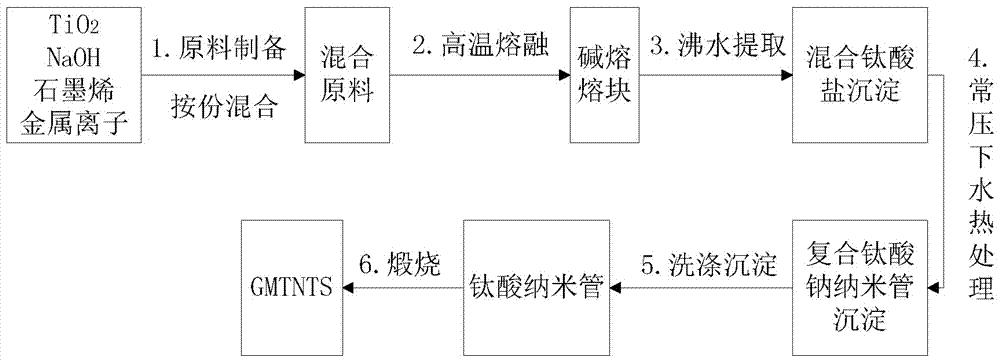A preparing method of a graphene-Au-TiO2 multi-component composite nanotube material
A multi-component composite and nanotube technology, applied in chemical instruments and methods, chemical/physical processes, physical/chemical process catalysts, etc., can solve problems such as increased production costs, low degree of crystallization, increased equipment investment, etc., to meet equipment requirements Effect of reduction, increase of specific surface area, reduction of hydrothermal time
- Summary
- Abstract
- Description
- Claims
- Application Information
AI Technical Summary
Problems solved by technology
Method used
Image
Examples
Embodiment Construction
[0040] Such as figure 1 As shown, a graphene-Au-TiO 2 The preparation method of multiple composite nanotube material comprises the following steps:
[0041] Step 1: Preparation of mixed ingredients:
[0042] Commercially available nanoparticle TiO 2 Weigh it with NaOH raw material according to the mass ratio of 1:8, and pour it into the corundum crucible; then weigh the graphene powder and gold compound with a mass percentage of 0.01-10.0wt%, and place them in the corundum crucible, and mix them thoroughly. Uniform, standby; wherein the metal ion Au in the compound of gold 3+ 0.01~5.0%;
[0043] Step 2: high temperature melting:
[0044] At room temperature, place the above-mentioned corundum crucible with mixed raw materials in a vacuum high-temperature furnace isolated from air, and close the furnace door;
[0045] Open the argon gas flow valve, and pass in argon gas for 30-120 minutes to remove the air in the furnace body;
[0046] Raise the temperature from room tem...
PUM
 Login to View More
Login to View More Abstract
Description
Claims
Application Information
 Login to View More
Login to View More - R&D
- Intellectual Property
- Life Sciences
- Materials
- Tech Scout
- Unparalleled Data Quality
- Higher Quality Content
- 60% Fewer Hallucinations
Browse by: Latest US Patents, China's latest patents, Technical Efficacy Thesaurus, Application Domain, Technology Topic, Popular Technical Reports.
© 2025 PatSnap. All rights reserved.Legal|Privacy policy|Modern Slavery Act Transparency Statement|Sitemap|About US| Contact US: help@patsnap.com

